The other day we published Part 1 of Daily Life of Tibetan Buddhist Nuns.
Since we had so many great photos, we decided to do Part 2 to give you a better idea of the many tasks that the nuns do in addition to their studies and practice.
As we said in Part 1, nunneries are complex institutions requiring a lot of hands-on work by the nuns to function smoothly. As you will see from the photos below, the nuns take an active role in running the nunneries. For instance, at Dolma Ling Nunnery, the largest of the 7 nunneries supported by the Tibetan Nuns Project and home to almost 250 nuns, there is a nuns’ committee that oversees the various aspects of nunnery life.

Nuns at Geden Choeling Nunnery in Dharamsala taking exams. In addition to their studies and Buddhist practice, Tibetan Buddhist nuns perform many other tasks to keep their nunneries running smoothly.
These leadership roles include kitchen managers who do the purchasing for the kitchen and are often directly involved in cooking; treasurers who are responsible for nunnery finances, running the nunnery store, and making purchases for the nunnery; and the keeper of the temple who makes the daily water offerings, lights the butter lamps, escorts visitors, and keeps the temple clean.
One of our goals at the Tibetan Nuns Project is to help the nuns achieve more self-sufficiency through skill building and income-generating projects. The nuns at Dolma Ling make a range of handicrafts such as prayer flags and malas for sale in the nunnery shop and through our online store. In spite of the various self-sufficiency projects, the nunneries still need outside support. The nuns are not in their own country. They are refugees and do not have access to major sources of revenue within India.
At Sherab Choeling Nunnery in the remote region of Spiti in the Indian Himalayas, the nuns must often shovel the snow in winter. This photo shows them shovelling the nunnery roof. During the winter of 2014/15, the weather was so severe that the nunnery ran out of cooking gas. For over two months the nuns had to rely solely on firewood to cook. The heavy snowfalls in the area meant that the nuns were unable to get supplies and all the local villages were cut off. In order to fetch water from the nearby village, the nuns had to clear a path through waist-deep snow.
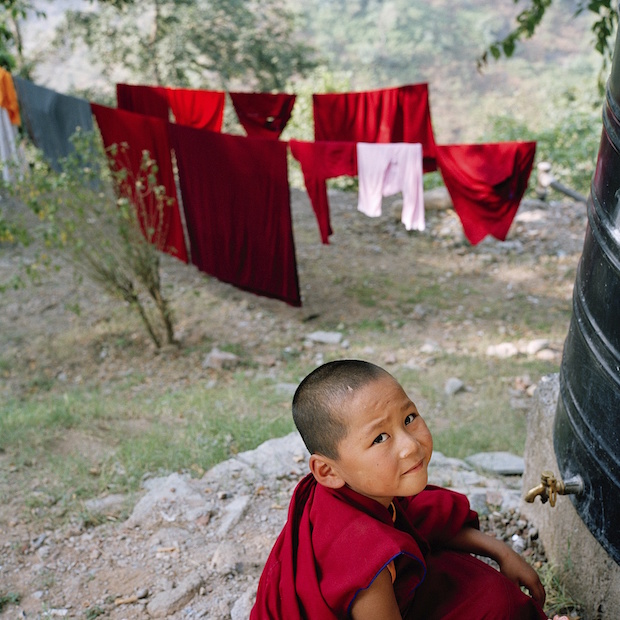
A young novice nun at Tilokpur Nunnery sits near the laundry line. Photo courtesy of Olivier Adam.
Washing clothes is done by hand and with a minimum amount of water. Nuns’ robes are hung to dry over a line, balcony railings, or sometimes fences or large boulders. Several of the nunneries supported through our sponsorship program are located in Himachal Pradesh which experiences extremely high rainfall during monsoon season. This makes drying anything a challenge.
The harsh sun and the torrential monsoon rains near Dharamsala in northern India take their toll on the wooden window frames at Dolma Ling Nunnery. Each year the nuns must carefully clean, sand, and refinish the wooden window frames in order to preserve them.

Nuns lift heavy bags of flour and rice in the storeroom of Geden Choeling Nunnery. Photo courtesy of Brian Harris
Based in Mcleod Ganj, Geden Choeling is the oldest nunnery in the Dharamsala area and is home to about 140 nuns. The nunnery follows the Gelugpa tradition and runs its own administration with the help of a Khenpo. They have a well-established education system and an office run by the nuns’ committee. The nunnery is also home to a number of elderly nuns, many of whom, became nuns later in life and who are taken care of in the nunnery by the younger nuns.

Nuns from Dolma Ling Nunnery leave early in the morning to go to the market to purchase supplies for the nunnery.
Last year, a number of generous donors enabled the nuns at Dolma Ling Nunnery to purchase a small, multi-purpose truck. With over 230 nuns at the nunnery, the nuns must travel often to buy vegetables, rice, oil, and other food, as well as supplies for the their small shop, the nunnery’s tailoring section, for the tofu-making facility, and for the paper-recycling section. Here’s a video made by the nuns showing a group setting off a 4 a.m. on a shopping expedition to the fruit and vegetable market.
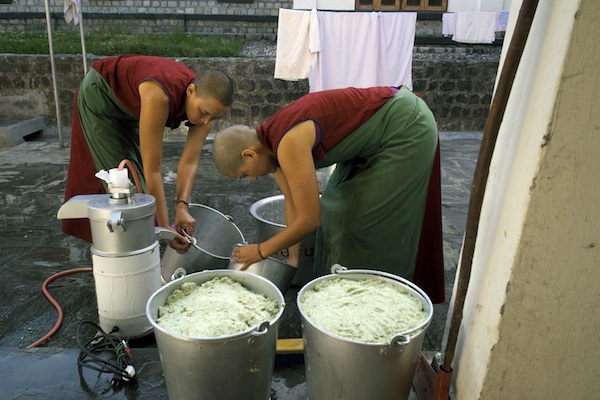
Nuns in 2013 making tofu at Dolma Ling Nunnery. Photo courtesy of Brian Harris.
The nuns at Dolma Ling make tofu every Saturday. Tofu is an important source of nourishment and protein for the nuns because they follow a vegetarian diet. The tofu is supplied regularly each week to the nunnery kitchen for consumption by the nuns and 2kg is bought every week by the nunnery café.
At Shugsep Nunnery, the nuns learn the flute and practice with their teacher. One of our donors, Sara in Virginia, wrote and told us, “I feel that Tibetan culture is unique and under threat, and that the political situation in Tibet itself is precarious, to say the least. I want to see all Tibetans find ways to live in the modern world, without losing what is valuable about their traditional Buddhist culture. The Tibetan Nuns Project is helping to meet these twin goals, of modernization and of preservation.”

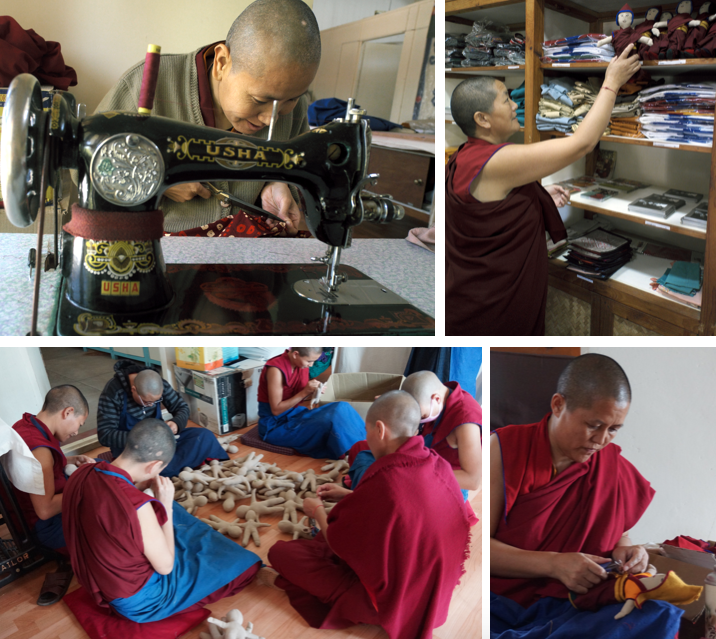
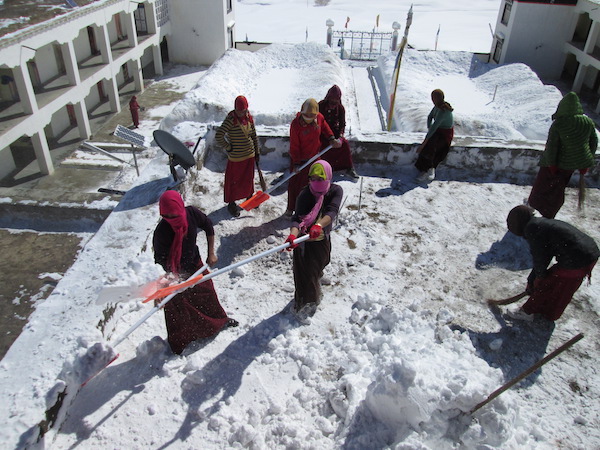

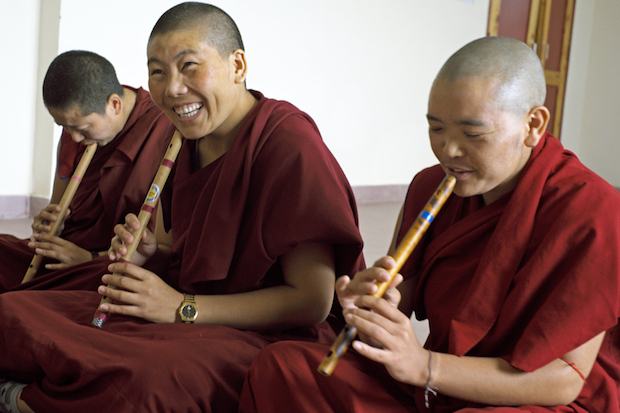
Thank you so much for letting us get a big look into the life of Tibetan Buddhist nuns. I have known several nuns living in the West, and they have a spiritual connection to the nuns in India and (to the extent possible) in Tibet. It helps to give positive news.
Thank you for your kind comment, Lisa, and your wonderful support.
Tashi delai -please chant for my people in Louisiana many lost their homes due to flooding 20,000
Please use these precious photos in your upcoming calendars and greeting cards.
Thank you for your consideration.
Kind Regards,
Patricia Chavez
Thanks so much, Patricia! The 2017 calendar is in design now and we’re excited to share it with you as soon as we can.
I LOVE reading about these wonderful nuns! I had no idea what they do on a daily basis. THANK YOU!
Thank you for your beautiful words and joy, Adele. We’re so happy that you enjoyed these blog posts.
Thank you Tibetan Nuns project for telling the world about how the Tibetan Nuns Live and the beautiful photos of the nuns. I hope you keep sending the world the lives of the Tibetan Nuns in India, Nepal and Tibet. Om Mani Padme Hum. david
Thank you so much, David. We’re delighted that you are enjoying the blog posts. Thank you so much for your sponsorship of Venerable Tanzin Angmo and for your dedication and compassion for the nuns.
May I know how one can become a nun? I feel drawn to the life and have wanted to be a Buddhist nun ever since I was fifteen. I spend all my free time studying dharma texts, and I sincerely wish to practice dharma throughout my life. I don’t know what the future holds, but I really wish to take ordination while I’m young and blue to study and possibly become capable of helping others.
Dear Megha, Those who wish to study Tibetan Philosophy will need an understanding of the Tibetan language. Studying at a local Tibetan Institute for a few months to a year proves beneficial for foreign nationals. Once the interviews have been conducted, nuns will provide a hair offering to a lama, start wearing robes and recite their vows.